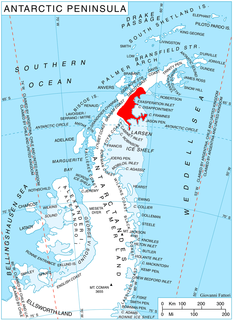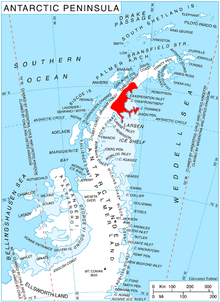
Thurston Island is an ice-covered, glacially dissected island, 215 km (134 mi) long, 90 km (56 mi) wide and 15,700 km2 (6,062 sq mi) in area, lying a short way off the northwest end of Ellsworth Land, Antarctica. It is the third largest island of Antarctica, after Alexander Island and Berkner Island.

The Ohio Range is a mountain range in the Transantarctic Mountains of Antarctica. It is about 48 km (30 mi) long and 16 km (10 mi) wide, extending WSW-ENE from Eldridge Peak to Mirsky Ledge. The range forms the northeast end of the Horlick Mountains and consists primarily of a large snow-topped plateau with steep northern cliffs and several flat-topped ridges and mountains. The highest point is the summit of Mount Schopf.

The Forrestal Range is a largely snow-covered mountain range, about 105 km (65 mi) long, standing east of Dufek Massif and the Neptune Range in the Pensacola Mountains of Antarctica. Discovered and photographed on January 13, 1956 on a transcontinental patrol plane flight of U.S. Navy Operation Deep Freeze I from McMurdo Sound to the vicinity of the Weddell Sea and return.

The Patuxent Range or macizo Armada Argentina is a major range of the Pensacola Mountains, comprising the Thomas Hills, Anderson Hills, Mackin Table and various nunataks and ridges bounded by the Foundation Ice Stream, Academy Glacier and the Patuxent Ice Stream. Discovered and partially photographed on January 13, 1956 in the course of a transcontinental nonstop plane flight by personnel of U.S. Navy Operation Deep Freeze I from McMurdo Sound to Weddell Sea and return.

Jason Peninsula is a large peninsula on the east coast of Graham Land comprising several mainly snow-covered summits. It rises above the Larsen Ice Shelf and extends from the narrow neck of land east of Medea Dome for 42 nautical miles (78 km), terminating in Cape Framnes. This feature was first seen from seaward on December 1, 1893 by Carl Anton Larsen, who named one of the high peaks "Mount Jason" after his ship, the Jason. Larsen was too distant to map the area in detail, but in 1902 the Swedish Antarctic Expedition under Otto Nordenskiöld observed the area from Borchgrevink Nunatak and reported the peaks seen by Larsen to be separated from the mainland. The name "Jason Island" was subsequently used for Larsen's discovery, but in 1955 the Falkland Islands Dependencies Survey determined this feature to be a large peninsula.

Cape Longing is a rocky cape on the east coast of Graham Land, Antarctica, forming the south end of a large ice-covered promontory which marks the west side of the south entrance to Prince Gustav Channel. It was discovered by the Swedish Antarctic Expedition under Otto Nordenskiöld in 1902, and so named by him because from the position of his winter hut on Snow Hill Island the cape lay in the direction of his "land of longing" which he was anxious to explore.

Snow Hill Island is an almost completely snowcapped island, 33 km (21 mi) long and 12 km (7.5 mi) wide, lying off the east coast of the Antarctic Peninsula. It is separated from James Ross Island to the north-east by Admiralty Sound and from Seymour Island to the north by Picnic Passage. It is one of several islands around the peninsula known as Graham Land, which is closer to South America than any other part of the Antarctic continent.

Dufek Massif is a rugged, largely snow-covered massif 27 nautical miles (50 km) long, standing west of the Forrestal Range in the northern part of the Pensacola Mountains. It was discovered and photographed on January 13, 1956 on a transcontinental patrol plane flight of U.S. Navy Operation Deep Freeze from McMurdo Sound to the vicinity of the Weddell Sea and return, and named by the Advisory Committee on Antarctic Names for Rear Admiral George J. Dufek, U.S. Navy, who was in direct operational command of U.S. Navy Task Force 43 during that operation. The entire Pensacola Mountains were mapped by the U.S. Geological Survey in 1967 and 1968 from ground surveys and U.S. Navy tricamera aerial photographs taken in 1964.

Drygalski Glacier is a broad glacier, 18 nautical miles long and 15 miles (24 km) wide at its head, which flows from Herbert Plateau southeast between Ruth Ridge and Kyustendil Ridge, and enters Solari Bay immediately north of Sentinel Nunatak on Nordenskjöld Coast, the east coast of Graham Land, Antarctica. It was discovered in 1902 by the Swedish Antarctic Expedition, under Otto Nordenskiöld, and named "Drygalski Bay" after Professor Erich von Drygalski. The feature was determined to be a glacier by the Falkland Islands Dependencies Survey in 1947.
Blackwall Ice Stream is a slightly S-shaped Antarctic ice stream about 240 nautical miles (440 km) long and 12 nautical miles (22 km) wide. It descends from about 1,900 metres (6,200 ft) to 730 metres (2,400 ft) where it joins Recovery Glacier between the Argentina Range and the Whichaway Nunataks. It was named after Hugh Blackwall Evans (1874–1975), an English-born Canadian naturalist with the British Antarctic Expedition, 1898–1900, led by Carsten E. Borchgrevink.

Borchgrevink Nunatak is a nunatak 1.5 nautical miles (3 km) long which rises to 650 metres (2,130 ft), standing at the south side of the entrance to Richthofen Pass, on the east coast of Graham Land. It was discovered in 1902 by the Swedish Antarctic Expedition under Otto Nordenskiöld, who named it for C.E. Borchgrevink, leader of the British Antarctic Expedition, 1898–1900, to Victoria Land.
Kuhn Nunatak is one of the Rambo Nunataks, lying 3 nautical miles (6 km) southwest of Oliver Nunatak on the west side of Foundation Ice Stream, in the Pensacola Mountains, Antarctica. It was mapped by the United States Geological Survey from surveys and U.S. Navy air photos, 1956–66, and was named by the Advisory Committee on Antarctic Names for Michael H. Kuhn, a meteorologist at Plateau Station, winter 1967.
Dott Ice Rise is a peninsula-like feature that is ice-drowned except for the Barrett Nunataks, about 20 nautical miles (40 km) long, extending eastward from the Heritage Range of the Ellsworth Mountains and terminating at Constellation Inlet at the southwest edge of Ronne Ice Shelf. It was mapped by the United States Geological Survey from surveys and U.S. Navy air photos, 1961–66, and was named by the Advisory Committee on Antarctic Names for Robert H. Dott, a United States Antarctic Research Program geologist and senior U.S. representative at Bernardo O'Higgins Base, summer 1961-62.
Schoofs Nunatak is an isolated nunatak 20 nautical miles (37 km) west-northwest of Mount Barkow, rising above the featureless ice plateau westward of the heads of Meinardus and Haines Glaciers, in Palmer Land. Mapped by United States Geological Survey (USGS) from surveys and U.S. Navy air photos, 1961-67. Named by Advisory Committee on Antarctic Names (US-ACAN) for Gerald J. Schoofs, radioscience researcher at Byrd Station, summer 1965-66.

Southard Promontory is a notable promontory, 6 nautical miles long and 2 nautical miles wide, which juts into northwest Mill Inlet between Breitfuss Glacier and Alberts Glacier, on the Foyn Coast, Graham Land. The promontory is bordered by steep rock cliffs which rise 1,500 metres (4,900 ft) to a relatively flat and snow covered upper surface. It was photographed from the air by Ronne Antarctic Research Expedition (RARE) and surveyed from the ground by Falkland Islands Dependencies Survey (FIDS) in 1947. In association with the names of Antarctic cartographers grouped in this area, named by the United Kingdom Antarctic Place-Names Committee (UK-APC) after Rupert B. Southard, Jr., Chief, National Mapping Division, United States Geological Survey (USGS), 1979–86; Chief, Office of International Activities, 1961–64; U.S. Representative to the SCAR Working Group on Geodesy and Cartography, 1964–79; Chairman, Domestic Names Committee of the USBGN, 1983-87.
The Horsa Nunataks are an isolated group of about five partly snow-covered nunataks, more than 610 metres (2,000 ft) high, which rise above Roberts Ice Piedmont, 14 nautical miles (26 km) north of Mount Calais, in the northeastern part of Alexander Island, Antarctica. They were first photographed from the air in 1936 by the British Graham Land Expedition under John Rymill, and were surveyed from the ground in 1948 by the Falkland Islands Dependencies Survey. The names for these nunataks and for the isolated Hengist Nunatak to the south are for the brother chieftains, Hengist and Horsa, who were believed to have led the first Saxon bands which settled England in the fifth century.

The Laputa Nunataks are a range of nunataks and snow-covered hills with minor rock outcrops, rising from about 500 metres (1,600 ft) to over 1,000 metres (3,300 ft), and located 6 nautical miles (11 km) northwest of Adie Inlet on the east side of Graham Land, Antarctica. They were first charted by the Falkland Islands Dependencies Survey and photographed from the air by the Ronne Antarctic Research Expedition in 1947. They were named by the UK Antarctic Place-Names Committee after Laputa, the flying island in Jonathan Swift's Gulliver's Travels.
The Lilliput Nunataks are three nunataks, from 600 to 700 metres high and trending southeast–northwest, located 3 nautical miles (6 km) north of Gulliver Nunatak on the east side of Graham Land, Antarctica. The nunataks are snow free on their southeast sides. They were charted by the Falkland Islands Dependencies Survey and photographed from the air by the Ronne Antarctic Research Expedition in 1947. The name, from Jonathan Swift's Gulliver's Travels, means land of small people and was applied by the UK Antarctic Place-Names Committee in association with Gulliver Nunatak.



![]()








